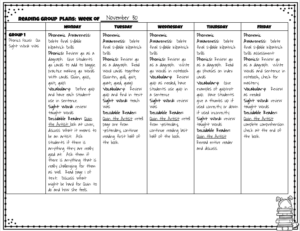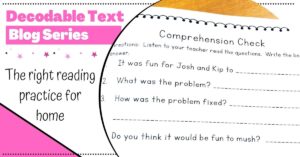Magic happens during my small group time now that I have switched to Decodable Readers rather than guided reading text. (Wondering Decodable Readers are? Check out this post to learn more!) To create these magical moments, check out this easy-to-use, carefully scaffolded plan that helps all readers expand their literacy skills.
*Note: This post was written when I taught first-grade small groups. It can be adapted to other grade levels as well.
This is a sample of my weekly first grade small group plans. I’ll break it down and explain the format of each day below.

Typically, my plans focus on one phonics skill per week. A skill is chosen based on assessments and data that tells me which skills my students need more practice with. The decodable readers I use feature the skill we are working on that week. My small groups are ideally twenty minutes each and I do three groups a day. These times are never exact, but it is what I aim for.
Day 1: Introduced Skill with Letter Cards
All readers have a little baggie with cards that contain all the phonics skills that we have worked on in small groups. (Tip: Cut an index card in half to write letters or digraphs on). Students use these cards to build words containing the skill we are working on. Some words that are in our decodable reader are built as well as some nonsense words.
After practicing with the cards, I like to review previously taught irregular or sight words. It is helpful to include a little vocabulary instruction each week too as it relates to our decodable reader as well. The last thing for day one is to take a peek at the new decodable reader. I do not do a picture walk, but rather preview the cover only and provide a text-to-self connection to the story. Hopefully, we have time to read a page or two from the book on the first day. ![]()



 Day 2: Read Word Cards
Day 2: Read Word Cards
Day two instruction starts with a mini-review of day one as needed, then students will read words (real and nonsense) on word cards that I hold up for the whole group. Reading the cards seems to take less time than the phonics instruction on the other days, so I also teach one sight word that may be unfamiliar from the decodable reader. We review our vocabulary words and find them in the text as well.
To jump back into our decodable reader, I do a little recall of what we read the day before if applicable. Following the recall, students read approximately half of the decodable reader to wrap up day two.
Day 3: Write Words
For day three students, we do some dictation practice in our small group notebooks. This day switches gears and students practice spelling words by writing them in their notebooks. Depending on time, I usually give around 5 words. After students write the words, I love to show them the word on a whiteboard or the index card from day two to read.
We review vocabulary and sight words as needed for the week. To finish up day three, students retell what they have previously read in the decodable reader and read the last half of the book.
Day 4: Read and Write Words and Phrases
Instruction begins on day four with a review of words as needed, and then moves into reading phrases containing the skill of the week. I love to include taught sight words in these phrases too. (This is also a great time to review complete/not complete sentences). If time allows, we will write a few phrases in our composition notebooks too on day 4.
To complete our lesson, I instruct students to reread the entire decodable reader. Hopefully, students will read with more fluency this time and many of the words will begin to be automatic. It is best to do all of the rereadings at the group table, but if we run out of time students will finish reading independently at their seats or centers.
Day 5: Read and Write Sentences and Assessments
Our last day of the week is our fluency day! (We work on fluency anytime we read, but today great reading fluency is explicitly taught) Students read complete sentences that contain our focus skill or skills of the week. I always try to include taught sight words as well. We really focus on reading fluency when we read these sentences together. For additional fluency practice, mix up the punctuation and model expression rather than robot reading on day 5 too.
Assessments
Day five is a great day to check for mastery of the skill we have focused on too. To assess my students, I just observe if students have mastered reading words and sentences that contain skill. Sometimes I do a running record with the decodable reader too. I also like to give a brief dictation assessment in our reading group composition notebooks. Hopefully, students will demonstrate mastery. If so, I will choose a new skill for the following week. Anytime students do not show mastery of the skill, we continue to work on it the following week if needed.
The last thing we do on day five is a comprehension check for our decodable reader. This consists of just a few questions that relate to the book we have read.

Want to receive a FREE decodable book from me? Click the book to sign up for my newsletter below! 
Don’t miss out on these freebies from my tpt store!
Decodable Text Mega Bundle in my TPT store
Free Level 1 Passages
Free Level 2 Passages
Free Level 1 Book
Here are some other options that I have used:
- Reading A-Z has a whole library of decodable text. Occasionally, I have difficulty matching it to my readers, but it was still a great resource. They offer a 15-day free trial that would definitely let you try their books out.
- Fly Leaf is offering ALL of their decodable texts for free at the time of this writing (11/23/2020). I like this company as well for students who have mastered consonants, short vowels, and some blends and phonics chunks.







No Comments